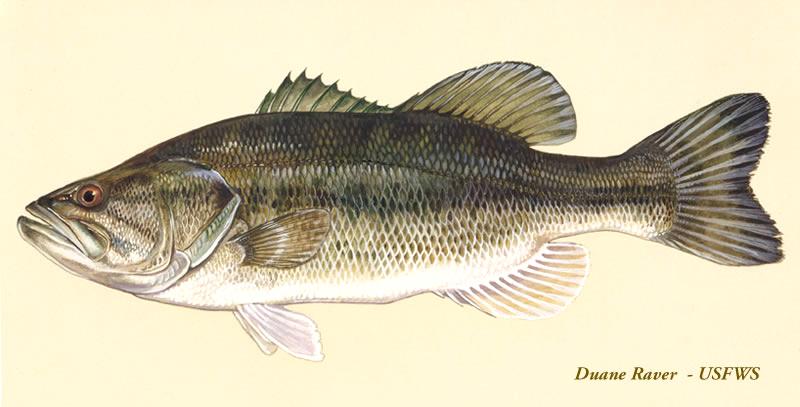Description and Range
Physical description
Largemouth bass is a member of the sunfish family, though larger than those species considered "panfish". Together with six other species of bass, they make up the group typically known as the black basses. Other than the largemouth, the only other member of the black basses in Washington is the similar looking smallmouth bass Micropterus dolomieu. Largemouth bass are less "flattened" and are longer than other sunfishes. They usually have a general greenish-black color to them, with a prominent dark horizontal band along their midline, whereas smallmouth bass are more of a brownish-green color with subdued dark vertical bands. Also, with their mouth closed, the maxillary (upper lip) of the largemouth bass extends fully past their eye, whereas in a smallmouth bass, it will reach only the middle of the eye.Average 12-15 inches. Largemouth bass can grow 17-20+ inches in quality populations. Contrary to popular belief, there is little difference in the growth or size of bass between eastern and western Washington.
Where you may encounter largemouth bass
Lakes where this species may be found
How to fish for largemouth bass
Fishing prospects calendar
Largemouth bass are one of the most popular game fish in the United States and there are probably more shapes, sizes, colors, and types of fishing gear available for largemouth bass than any other species. The same can probably be said for fishing techniques. The type of gear you choose will depend upon water temperature and clarity, as well as the type of structure you are fishing around. The key to successful bass fishing is to understand the seasonal and daily movements that bass make, and to choose your gear and fishing techniques accordingly.
Largemouth bass generally inhabit areas of dense cover around fallen trees, brush piles, and thick vegetative cover. Small fish will eat zooplankton and insects, but their diet will switch over to fish at a small size. Adult bass consume a wide variety of prey items from fish and insects to small rodents, birds, and some amphibians and the best lures mimic their favorite prey items.
In cold water, slow presentation works best. Look for calm water areas and, if possible, areas that are in the sun. Baits like a jig-and-pig, Texas-rigged plastic worms, spinner baits, and crankbaits with a fast wobble work good when fished slowly. It takes a little more effort to coax a bass to bite in cold water, so work an area of cover methodically and completely before moving on. In warmer water when the bass are shallow, jerk baits, shallow running crankbaits, and top water baits can work well early in the morning. Later in the day, try plastic worms, grubs, and tube baits around creeks or in slightly deeper water as bass move away from the shore. There are a lot of good rod/reel combos available, choose appropriately based on the baits you are using, but in general a 7'6" rod is sufficient, with a spinning reel for throwing plastics and spoons, and a baitcasting reel for jigs and plugs.
Fly fishing for bass is increasing in popularity and there is a lot of information available on this sport. An 8 foot, 5 or 6-weight rod is sufficient, using deer hair poppers, streamers, or foam bodied hoppers. Large flies resembling a dragon fly can be productive as well. The internet has scores of information on bass fishing.
State record
- Weight
- 12.53 lbs
- Angler
- Bill Evans
- Location
- Lake Bosworth, Snohomish County
- Date Caught
- August 8, 2016
